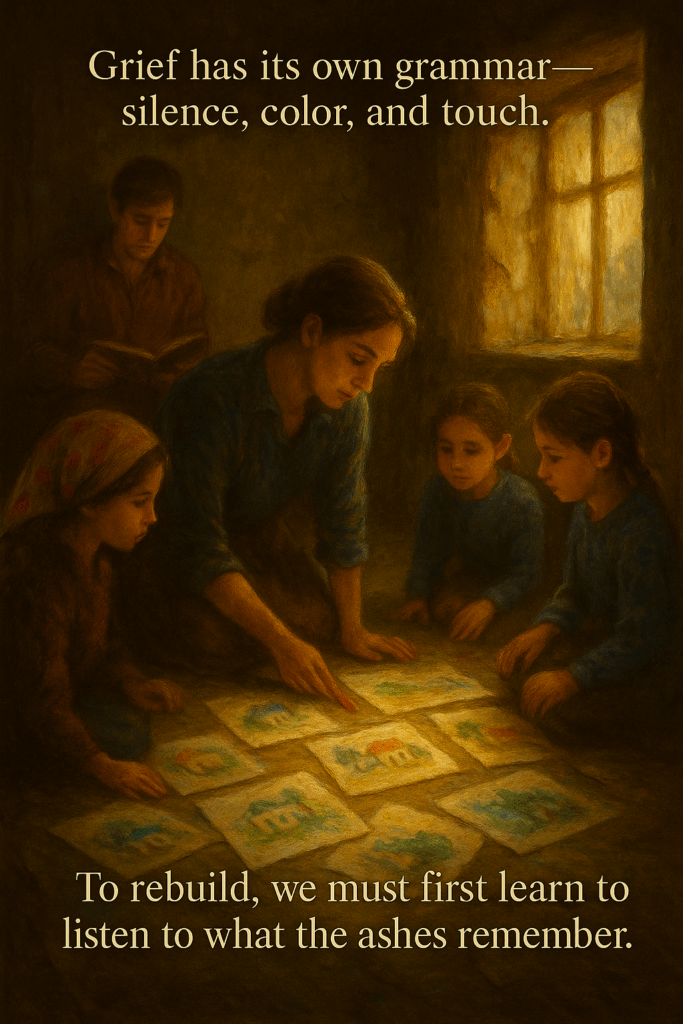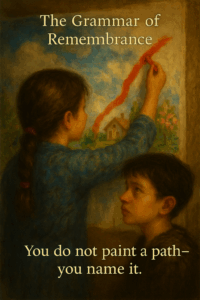
Morning came pale and brittle, the kind of light that seemed afraid to touch the walls. The generator had stopped in the night; its silence left the air feeling too honest.
Emil woke to the faint hum of a kettle and the soft clatter of brushes. Aisha was already at the wall, eyes tracing yesterday’s strokes. The crimson line still glowed faintly in the dawn — the only warmth against the gray.
“Power’s back,” Jaden said, yawning as he rewired a lamp. “Half the city’s still dark.”
Olena poured tea into chipped mugs. “They say the sky cleared last night. You can almost hear it breathe.”
Emil opened the ledger. The pages smelled faintly of metal and dust — Kyiv air pressed into paper. He reread his note from the night before: Do not paint over wounds — paint the space they ask for.
He wondered if space could be enough.
By midmorning, the shelter stirred to life. Sofia arrived with new supplies — more paper, a box of crayons, and a stack of children’s drawings rescued from the ruins of a school.
She spread them on a table: houses without roofs, mothers with missing hands, trees with roots in clouds.
“These are from before,” she said quietly. “We used to keep them in a folder called Home as Remembered. I thought your group might understand what to do with them.”
Aisha’s breath caught. The children gathered, whispering names under their breath as if recognizing ghosts. Danylo stood apart, arms crossed.
“We could add them to the mural,” Mina suggested.
“No,” Aisha said softly. “Not yet. Let them speak first.”
She began laying the drawings side by side on the floor, aligning their broken edges — fragments forming something larger. Emil noticed how the crayon lines seemed to tremble, like the memory of steady hands.
He crouched beside a picture of a blue roofed house and asked, “Whose is this?”
The little girl who had written I miss my window raised her hand. “Mine,” she said. “It used to have a swing.”
“Where is it now?”
The girl shrugged. “In the sky.”
Silence folded over the room.
Aisha knelt and touched the paper, her voice barely more than a breath. “We’ll build from this sky then — not to bring it down, but to remember how it looked before it fell.”
That day, the Circle worked differently. There were no plans, no color maps.
Instead, they translated grief — from drawing to gesture, from sound to silence.
Mina catalogued each child’s artwork, assigning tones to emotion:
Gray for what was lost, gold for what still lived, red for what refused to forget.
Priya built a visual mosaic of these tones — a digital pulse that shimmered on her laptop like embers.
Aisha mirrored it on the wall, smudging charcoal and chalk, letting the children guide her hand.
Taras returned from outside carrying a piece of broken stained glass.
“This was from a church,” he said. “The window fell, but the color stayed.”
He set it near the mural where the light caught it, scattering shards of blue across the paper.
Danylo finally stepped closer. “Why are you painting the sad ones first?”
Aisha turned to him. “Because sadness is the only color that tells the truth at the start.”
He frowned. “Then there will be no room for happy ones.”
“There will,” Emil said. “But joy doesn’t grow from pretending the ashes aren’t there. It grows when something burns and still remembers to glow.”
Danylo looked away, his jaw tight.
A few minutes later, he returned with one of the “before” drawings — his brother’s. It showed two boys flying kites over a yellow field.
He taped it to the wall beside the crimson path.
“Then start here,” he said.
By afternoon, the mural had become a dialogue — fragments of past and present coexisting.
The Home as Remembered pieces were no longer mere drawings; they were echoes repainted — outlines of absence filled with shared color.
Sofia moved among them, helping translate.
“This one,” she said, pointing to a child’s picture of a broken window, “says I watched the sun hide behind smoke and thought it was night.”
Mina recorded the phrase, her voice trembling slightly as she added it to their archive.
Emil watched the wall evolve — not brighter, but deeper.
Each mark seemed to acknowledge pain and then give it form, like language emerging from breath.
He realized the children were not learning art; they were teaching remembrance.
This was not therapy. It was testimony.
As dusk fell, the generator flickered back on, casting their shadows onto the mural. For a moment, it looked as if the figures in the painting were alive — reaching out through ash and light.
Aisha stood back and wiped her hands, streaked with gray and gold.
“It’s not finished,” she said.
Sofia smiled faintly. “Neither are we.”
Emil closed the ledger and opened to a new page.
Ledger Entry — The Language of Ashes
Date: March 4, 2026
Symptom:
Children’s memories re-emerge through fragments of pre-war drawings; grief transforms into creative dialogue. Emotional expressions shift from silence to shared participation. Trust deepening; grief becoming communicable.
Disease — The Four Absences (Local Context):
-
Absence 1 (Exclusion): Cultural and emotional divides remain; outsiders still rely on translation to grasp local grief; shared vocabulary of pain not yet formed.
-
Absence 2 (Vengeance): Anger and bitterness linger beneath nostalgia; loss occasionally frames outsiders as intruders; emotional release risks turning accusatory.
-
Absence 3 (Dehumanization): Children’s art once catalogued as damage reports; their emotions treated as background noise rather than lived history.
-
Absence 4 (Unheard Cry): Memories of destroyed homes and lost family remain unspoken; grief buried under survival routines; expression still fragmented and hesitant.
Investigator’s Response:
Facilitated translation of grief through children’s pre-war art; integrated “Home as Remembered” into mural dialogue; emphasized authenticity of pain before beauty; employed tonal mapping (gray loss, gold life, red remembrance, green continuity); honored Danylo’s contribution of brother’s drawing as communal bridge.
Outcome:
Children express ownership of mural; Sofia mediates emotional translation; emotional vocabulary of the shelter expands; mural evolves into collective memoryscape.
Trust among local youth stabilizes; creative agency replaces passivity.
Note:
Ashes are not an end—they are what remain when fire remembers.
Peace begins when memory learns to speak without blame.
That night, the shelter was quieter than usual.
The wind had softened, and for once the air did not smell of smoke.
Emil lay awake listening to the faint tapping of brushes being rinsed in metal cups.
He thought of Danylo’s crimson path, now winding past the fragments of old drawings — connecting what was broken without forcing it whole.
He whispered to himself: “The ashes are speaking.”
And somewhere beyond the cracked windows, the first snowflakes began to fall again — not erasing, only covering, as if the sky, too, had learned the language of remembrance.


